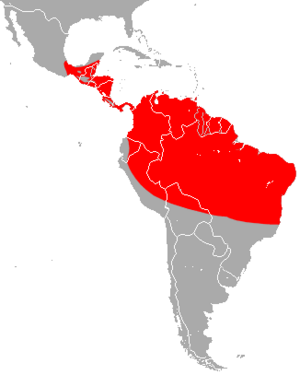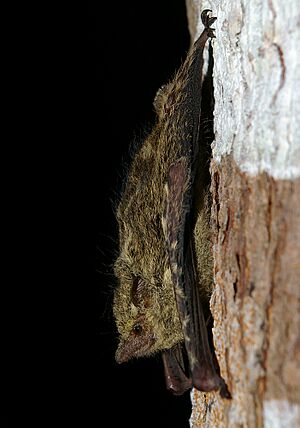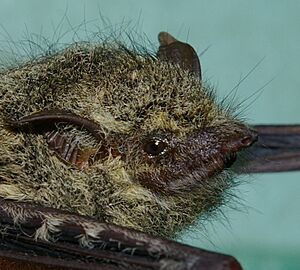Proboscis bat facts for kids
Quick facts for kids Proboscis bat |
|
|---|---|
 |
|
| Conservation status | |
| Scientific classification | |
| Genus: |
Rhynchonycteris
|
| Species: |
naso
|
 |
|
| Proboscis bat range | |
| Synonyms | |
|
|
The proboscis bat (Rhynchonycteris naso) is a small bat found in parts of South and Central America. People also call it the long-nosed proboscis bat or river bat. It is the only species in its group, known as Rhynchonycteris.
This bat belongs to the family called Emballonuridae. These are also known as sac-winged or sheath-tailed bats. Like most bats, the proboscis bat is active at night. You can find it from southern Mexico all the way to Brazil and even on the island of Trinidad.
Contents
What Does a Proboscis Bat Look Like?
The proboscis bat is a very small bat. It is usually about 6 centimeters (2.4 inches) long. It weighs around 4 grams (0.14 ounces), which is less than a stack of two pennies!
Female bats can be a little bit bigger than males. For example, females might be 59 millimeters (2.3 inches) long. Males are usually around 56 millimeters (2.2 inches) long. Their tail is about 16 millimeters (0.6 inches) long. Pregnant females can weigh up to 6 grams (0.21 ounces).
Where Do Proboscis Bats Live?
Proboscis bats live in the low-lying areas of northern South America. They are also found throughout Central America and into southeastern Mexico. In countries like Ecuador, they live only to the east of the Andes mountains. Their home range goes south into Bolivia and a large part of Brazil.
These bats usually live in places that are not very high up. They are rarely found above 300 meters (984 feet) in elevation. They love to live near water, like wetlands, rivers, and swamps. You can often spot them in forests close to rivers or in wet pastures.
How Proboscis Bats Live
Proboscis bats are social animals and live together in groups.
Living in Groups
A group of proboscis bats is called a colony. These colonies usually have about five to ten bats. Sometimes, a colony might have as many as forty bats, but this is rare.
Since they are nocturnal, they sleep during the day. They have a very interesting way of sleeping! They line up one after another on a branch or a wooden beam. They sit nose to tail in a straight row.
What Do They Eat?
Each colony of proboscis bats usually has a special area where they like to hunt for food. This is often a small patch of water. The bats catch insects that fly near the water. They use a special skill called echolocation to find their prey.
Echolocation means they send out sounds and listen for the echoes. This helps them know where objects are, even in the dark. They mostly eat insects like midges, mosquitoes, beetles, and caddisflies.
Proboscis Bat Life Cycle
Proboscis bats do not have a specific time of year when they have babies. They form stable groups all year round. Each female bat usually gives birth to one baby at a time.
The young bats stay with their mothers for about two to four months. After this time, they are ready to leave their parents. Both male and female young bats will then go off to find their own places to live.
Sometimes, these small bats can become food for other animals. For example, a large spider called Argiope savignyi has been known to catch proboscis bats.
Images for kids






